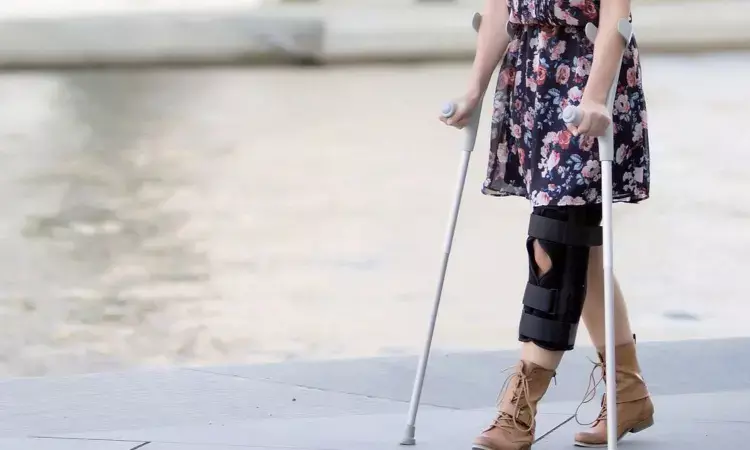- Home
- Medical news & Guidelines
- Anesthesiology
- Cardiology and CTVS
- Critical Care
- Dentistry
- Dermatology
- Diabetes and Endocrinology
- ENT
- Gastroenterology
- Medicine
- Nephrology
- Neurology
- Obstretics-Gynaecology
- Oncology
- Ophthalmology
- Orthopaedics
- Pediatrics-Neonatology
- Psychiatry
- Pulmonology
- Radiology
- Surgery
- Urology
- Laboratory Medicine
- Diet
- Nursing
- Paramedical
- Physiotherapy
- Health news
- Fact Check
- Bone Health Fact Check
- Brain Health Fact Check
- Cancer Related Fact Check
- Child Care Fact Check
- Dental and oral health fact check
- Diabetes and metabolic health fact check
- Diet and Nutrition Fact Check
- Eye and ENT Care Fact Check
- Fitness fact check
- Gut health fact check
- Heart health fact check
- Kidney health fact check
- Medical education fact check
- Men's health fact check
- Respiratory fact check
- Skin and hair care fact check
- Vaccine and Immunization fact check
- Women's health fact check
- AYUSH
- State News
- Andaman and Nicobar Islands
- Andhra Pradesh
- Arunachal Pradesh
- Assam
- Bihar
- Chandigarh
- Chattisgarh
- Dadra and Nagar Haveli
- Daman and Diu
- Delhi
- Goa
- Gujarat
- Haryana
- Himachal Pradesh
- Jammu & Kashmir
- Jharkhand
- Karnataka
- Kerala
- Ladakh
- Lakshadweep
- Madhya Pradesh
- Maharashtra
- Manipur
- Meghalaya
- Mizoram
- Nagaland
- Odisha
- Puducherry
- Punjab
- Rajasthan
- Sikkim
- Tamil Nadu
- Telangana
- Tripura
- Uttar Pradesh
- Uttrakhand
- West Bengal
- Medical Education
- Industry
Study provides insight into best bracing method for traumatic patellar dislocation

Finland: Following a first-time traumatic patellar dislocation, the use of a patella-stabilizing, motion-restricting knee brace for 4 weeks did not significantly reduced redislocations compared to a neoprene nonhinged knee brace, a recent study stated. The study appears in The American Journal of Sports Medicine.
The randomized controlled trial although was underpowered for detectinintog more modest differences. Further, the study found that knee immobilization was associated with less knee ROM, quadriceps muscle atrophy, and worse functional outcomes in the first 6 months following the injury.
In adoleecsts and young adults, a traumatic lateral patellar dislocation is a common injury. The treatment of majority of first–time dislocations can be done nonoperatively. Sevreal types of knee braces are used for nonoperative treatment, but there is a lack of the most preferred bracing method. To fill this knowledge gap, Essi E. Honkonen, Unit of Musculoskeletal Surgery, Department of Orthopaedics, Tampere University Hospital, Tampere, Finland, and colleagues aimed to investigate the efficacy of a patella–stabilizing, motion-restricting knee brace compared to a neoprene nonhinged knee brace for the treatment of a first–time traumatic patellar dislocation at 3 years of follow–up.
The study enrolled a total of 101 skeletally mature patients with a first–time traumatic patellar dislocation. After exclusion, 79 patients with a first–time traumatic patellar dislocation were randomized and allocated into 2 study groups: group A, with a patella–stabilizing, motion-restricting knee brace (hinged to allow knee range of motion [ROM] of 0°-30°) and group B, with a neoprene nonhinged knee brace (not restricting any knee motion).
Similar physical therapy instructions were given to both the groups and were advised to use the brace continuously for 4 weeks. Overall, 64 patients completed the trial.
The study led to the following findings:
· The redislocation rate in group A was 34.4% and in group B it was 37.5% (risk difference, –3.1%).
· Patients in group A had less knee ROM than those in group B at 4 weeks (90° vs 115°, respectively) and 3 months (125° vs 133°, respectively).
· Patients in group A had more quadriceps muscle atrophy than patients in group B at 4 weeks (24/32 vs 16/32, respectively) and 3 months.
· At 6 months, patients in group B reported better functional outcomes than patients in group A (Kujala score mean difference, 4.6), although no clinically relevant difference was found at 3 years.
To conclude, "knee immobilization was associated with quadriceps muscle atrophy, less knee ROM, and worse functional outcomes in the first 6 months after the injury."
Reference:
Honkonen EE, Sillanpää PJ, Reito A, Mäenpää H, Mattila VM. A Randomized Controlled Trial Comparing a Patella-Stabilizing, Motion-Restricting Knee Brace Versus a Neoprene Nonhinged Knee Brace After a First-Time Traumatic Patellar Dislocation. The American Journal of Sports Medicine. 2022;50(7):1867-1875. doi:10.1177/03635465221090644
Dr Kamal Kant Kohli-MBBS, DTCD- a chest specialist with more than 30 years of practice and a flair for writing clinical articles, Dr Kamal Kant Kohli joined Medical Dialogues as a Chief Editor of Medical News. Besides writing articles, as an editor, he proofreads and verifies all the medical content published on Medical Dialogues including those coming from journals, studies,medical conferences,guidelines etc. Email: drkohli@medicaldialogues.in. Contact no. 011-43720751


